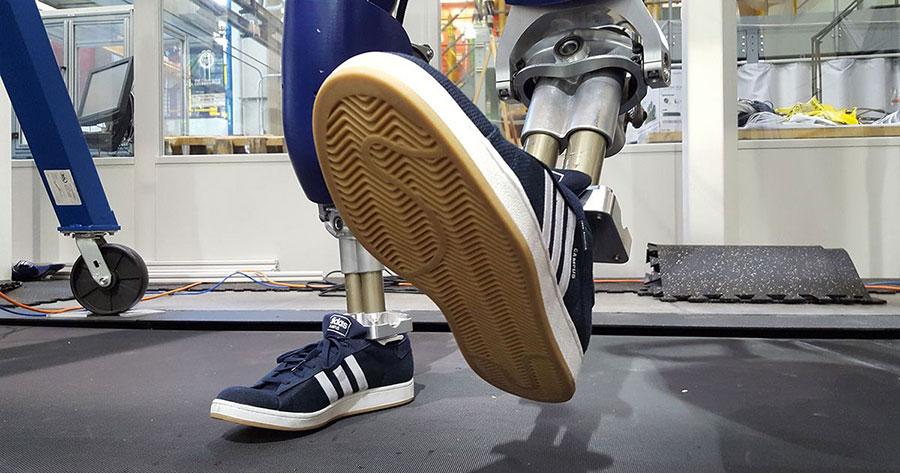Georgia Institute of Technology has presented a new humanoid capable of walking using size-13 sneakers. The robot depends on its heels and toes to move, just like humans. It fell to the floor during three days, until students developed better-walking algorithms.
The human-like machine called DURUS was prepared by the AMBER Laboratory. Researchers have described their creation as “the most efficient walking humanoid ever created.” Other similar robots depend on structures attached to their waist, to walk. Aaron Ames, a professor in the George W. Woodruff School of Mechanical Engineering, said the machine imitates human locomotion.

“Our robot is able to take much longer, faster steps than its flat-footed counterparts because it’s replicating human movement. Multi-contact foot behavior also allows it to be more dynamic, pushing us closer to our goal of allowing the robot to walk outside in the real world,” Said Ames in a press release.
DURUS’ secret to be a different humanoid: very sophisticated algorithms
Professor Ames said that traditional humanoids try to replicate an “upside-down pendulum.” As a result, they are capable of moving their upper body, to drag their flat feet on the ground. However, they cannot move showing the same “dynamic grace” than humans, added Ames.
DURUS used to walk correctly as other robots until last week when researchers have developed a new potent algorithm. The team immediately equipped the humanoid with metal feet and arched soles.
The mathematical operations did not work during the first three days. On the fourth day, researchers were already observing how the robot moved in a “dynamic” way using its new tools. DURUS is powered by metal high heels and toes and springs between its leg parts.
Researchers have developed a structure similar to human tendons. DURUS’ ankles and feet are connected. As a result, it is capable of “storing mechanical energy from a heel strike” to impulse his walking.
Ames told the Washington Post he is excited about the cool factor surrounding DURUS. He also admitted that the new technology has “a lot of really important applications.” Investigators have worked over years to develop humanoids.
Mathematical equations processed by DURUS are so complex that they would occupy “thousands of pages” if they had to be written, Ames told the Post.
This robot built at Georgia Tech walks like a human and wears tennis shoes. #WeCanDoThat | https://t.co/KglN2lxWUR pic.twitter.com/tr7LK5AelW
— GeorgiaTech (@GeorgiaTech) July 12, 2016
Olympics of the future? Researchers want to build robots capable of running across a field
DURUS’ way of walking looks very efficacious for a 2016 robot. Researchers explained there’s a way to measure robot locomotion efficiency called “cost of transport.” The latter can be obtained by dividing the energy it uses by the humanoid’s walking speed and weight.
Professor Ames said that DURUS achieves a level of 1.4, while similar robots enter into the 3.0 level. The recently-developed humanoid is self-powered, which means it does not depend on an outside source.
DURUS can walk for five hours using only batteries. Professor Ames told the Post he hopes to see humanoids “in disaster scenarios and space exploration.” Robots would have to learn how to stand by themselves after falling on the ground to achieve that.
“Flat-footed robots demonstrated that walking was possible. But they’re a starting point, like a propeller-powered airplane. It gets the job done, but it’s not a jet engine. We want to build something better, something that can walk up and down stairs or run across a field,” Said Ames, who is also the director of the Georgia Tech lab.
The new findings can help improve prostheses and exoskeletons, designed for impaired people seeking to walk. This technology could also support a new segment of robots capable of participating in races.
DURUS is the result of a student project lead by Georgia Institute of Technology graduate Jake Reher, said the institution in a press release. The sneakers used by the humanoid, which resemble a pair of classic Adidas, were developed by Eric Ambrose.
strutting robot is strong, confident and has great shoes DURUS replicates the gait of its puny human creators.#Robot pic.twitter.com/WMxgv26hWF
— ArvinD✏ (@1amarvind) July 13, 2016
Are you a defensor or a skeptic of robots? The Dallas shooter was killed using a machine
Robot advocates and skeptics have argued this week about the usage of killer robots managed by governments. Dallas Police Chief David Brown confirmed this week that the Dallas shooter Micah Johnson was killed by a robot using a bomb.
Brown admitted he had to overcome an ethical dilemma to kill Johnson using a robot. He remarked he would take the same decision again to save the life of a police officer because other options “would have affected” more people, as reported by The Guardian.
On the other hand, British astronaut Tim Peake told News Scientists that robots wouldn’t be able to do his job for the next 100 years. He said he supported space travels to Mars and the moon with humans aboard.
Dallas Chief says he told his officers to get creative in taking out the gunman. They came up with the robot bomb. pic.twitter.com/NlxapbbwWp
— David Mack (@davidmackau) July 10, 2016
Source: Georgia Institute of Technology Press Release
